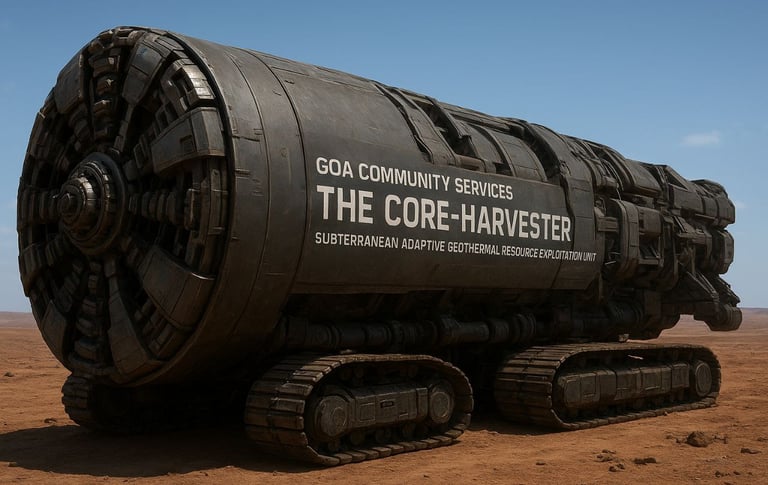S.A.G.R.E.U. (Subterranean Adaptive Geothermal Resource Exploitation Unit)
The Core-Harvester (S.A.G.R.E.U.) is a revolutionary, massive subterranean machine designed to be a self-sustaining explorer, infrastructure builder, and refinery at extreme geological depths.
Machine Capabilities:
Deep-Earth Penetration: It drills and tunnels continuously, creating permanent, concrete-lined subterranean infrastructure (like an underground highway network) reaching depths near the Earth's core layers (≈10 km).
Adaptive Resource Extraction: It can dynamically switch its method based on the material encountered:
Solid: Uses massive torque and a diamond drill head to crush and extract rock/ores.
Liquid/Fluid: Uses air suction and flash-evaporation (like distillation) to purify and extract liquid minerals (e.g., oil, brines) without physical contact.
Magmatic: Uses plasma arcs and chemical leaching (with supercritical fluids) to extract elements directly from superheated rock and molten material.
In-Situ Refining: It processes raw materials inside the machine underground, sending only refined, high-value resources to the surface, minimizing environmental impact and surface waste.
Self-Powering: It transitions from a chemical (oxygen-combustion) engine to an efficient geothermal power plant, drawing immense, renewable energy directly from the Earth's heat gradient to sustain its own operations.
Core Purpose:
The Core-Harvester's purpose is to provide continuous, sustainable access to the planet's deepest and most valuable resources—specifically geothermal energy and rare earth elements—while simultaneously constructing a permanent subterranean network for future scientific exploration and resource transportation.
Adaptive Geomechanical Systems Sovereign
Integrated Deep-Earth Systems Engineering
This machine, which we've named the Subterranean Adaptive Geothermal Resource Exploitation Unit (S.A.G.R.E.U.) or The Core-Harvester, requires a highly advanced and resilient engineering design. We have an extensive, sturdy breakdown of the machine's components and systems.


GOA Community Services Science Research Institute
"The Core-Harvester"
Project S.A.G.R.E.U., also known as the Core-Harvester, represents a pioneering step in deep-earth science and engineering. Conceived under the GOA Community Services Science Research Institute initiative, the project envisions a subterranean platform capable of tunneling, energy harvesting, and adaptive resource extraction under extreme geological conditions. By integrating structural resilience, multi-phase extraction systems, geothermal power transition, and AI-driven navigation, S.A.G.R.E.U. establishes a foundation for long-term deep-earth exploration, mineral recovery, and sustainable energy harnessing.
This white paper presents the engineering breakdown, system architecture, and operational vision for S.A.G.R.E.U., positioning it as one of the most ambitious underground exploration and energy projects of the modern era.
1. Introduction
The earth's crust harbors immense untapped resources: rare earth elements, geothermal energy reservoirs, and advanced mineral structures. However, access to these resources is limited by extreme conditions—pressure, temperature, and chemical reactivity. Current tunneling technologies, designed for mining or civil engineering, cannot sustain operations at depths where pressures exceed 1 GPa and temperatures surpass 500 °C.
Project S.A.G.R.E.U. proposes a solution: a resilient, modular subterranean adaptive unit that functions as a self-sustaining tunneler, energy converter, and mineral processor. Its systems adapt dynamically to solid, liquid, and magmatic geological phases, making it capable of reaching unprecedented depths.
⚙️ S.A.G.R.E.U.: System Engineering Breakdown
I. Structural & Material Science (Hull and Chassis)
The Core-Harvester's body must withstand extreme geopressure (up to ≈1 GPa) and geothermal temperatures (up to 500∘C or more).
Primary Hull Material: A Refractory Metal Superalloy (e.g., Niobium-Hafnium-Titanium composite or a specialized Tungsten alloy) enhanced with Ceramic Matrix Composites (CMCs) for thermal insulation and high-temperature creep resistance.
Specification: Must maintain a minimum Yield Strength of 1.5 GPa at 500∘C.
Segmented Articulation: The body isn't rigid; it's a series of modular, linked segments, similar to a tunneling machine but with greater flexibility. This allows for navigation through fractured rock and mitigates stress concentration from localized pressure.
Tunnel Stabilization System: Immediately behind the extraction head, a rapid-set, high-strength Geopolymer Concrete injection system is employed.
Function: Lines the tunnel walls to prevent immediate collapse and create the permanent infrastructure. The concrete must have a low coefficient of thermal expansion (α) to resist cracking.
II. Propulsion and Power Systems (Torque and Endurance)
The system shifts between chemical and geothermal energy depending on depth.
A. Initial Power Plant (The Oxygen-Based Combustion Engine)
Type: A massive, sealed-cycle Turbo-Shaft Engine capable of generating high torsional moment (the power of a cruise ship engine, estimated at ≈80−100 MW sustained output).
Fuel/Oxidizer: Liquid Methane (LCH4) fuel (stored) and Compressed Oxygen (LO2) piped from surface reservoirs or extracted from subsurface CO2 or water via a compact Solid Oxide Electrolysis Cell (SOEC) unit. The "exposed air" concept is modeled as a regulated, controlled intake/recirculation chamber.
Cooling and Lubrication: A closed-loop, high-pressure liquid Sodium-Potassium eutectic alloy (NaK) cooling system circulates near the core components. Lubricants must be Perfluoropolyether (PFPE) or synthetic molten salts for operation at >300∘C.
B. Geothermal Power Transition
Mechanism: Deep underground, dedicated Thermionic Converters and Seebeck Generator Arrays (using materials like Silicon-Germanium SiGe) are installed on the hull.
Function: Convert the massive thermal gradient between the hot rock face and the internal cooling system directly into electrical energy. This supplements or eventually replaces the combustion engine.
Output: Geothermal power drives high-efficiency Electric Drive Motors which translate electrical energy back into mechanical torque for the drill head.
III. Extraction and Conversion Systems (The Adaptive Head)
The machine's revolutionary feature is its Tricameral Extraction Module designed for phase-adaptive operation.
A. Phase 1: Solid (Mechanical Drilling)
Drill Bit: A Polycrystalline Diamond Compact (PDC) bit brazed onto a Tungsten Carbide matrix.
Wear Management: Automated replacement system using a magazine of spare bits. Bit performance is monitored by embedded strain gauges and acoustic emission sensors.
Muck Handling: Crushed rock (Muck) is moved to the surface via a Continuous Bucket Elevator System (CBES) integrated with high-pressure Hydro-cyclones for initial mineral separation in situ.
B. Phase 2: Liquid (Suction and Phase-Change)
Suction Mechanism: A variable-speed Magnetohydrodynamic (MHD) Pump uses electromagnetic fields to move conductive liquids/slurries without moving mechanical parts, reducing wear.
Conversion Chamber: A Flash Evaporation Unit uses the machine's internal heat. The liquid mineral stream is depressurized and heated, causing rapid vaporization. The resulting high-purity vapor is then routed into a Fractional Condenser Column to separate components based on boiling points.
C. Phase 3: Magmatic (Geothermal Extraction)
Bore Mechanism: A Plasma Torch Drill (using an Argon-based plasma at >10,000∘C) locally vaporizes rock to create the initial void.
Extraction: Chemical Leaching and Thermo-Separation are primary.
The machine injects a specific, super-critical fluid (e.g., supercritical CO2) which acts as a solvent to selectively dissolve target rare earth elements/minerals from the molten rock.
The solute is then subjected to Electrochemical Deposition within a cooled chamber, plating the purified mineral onto collection electrodes.
IV. Control, Navigation, and Data Acquisition
Guidance System: A Dead Reckoning Inertial Navigation System (INS) is constantly updated by Gravimeters and Magnetometers to accurately map the subterranean environment and correct for drilling deviations (e.g., azimuth and inclination control).
Teleoperation & Autonomy: Uses a Fiber Optic Tether for high-bandwidth data transmission to the surface control center. Onboard AI-driven Autonomy is essential for real-time adaptation of drilling parameters (thrust, rotational speed, feed rate) based on Rock Mass Rating (RMR) measurements from forward-looking ultrasonic sensors.
Geochemical Analysis: An embedded, automated Laser-Induced Breakdown Spectroscopy (LIBS) unit performs continuous, real-time chemical analysis of the surrounding rock and extracted fluid, allowing the machine to dynamically adjust its mining target.
Executive Summary
2. Structural & Material Science (Hull and Chassis)
2.1 Operating Environment
Depth: Multi-kilometer crust penetration.
Pressure: Up to 1.0 GPa.
Temperature: 500 °C average, with localized spikes up to 800 °C.
2.2 Hull Composition
Primary Alloy: Niobium–Hafnium–Titanium composite or Tungsten-based refractory alloy.
Thermal Insulation: Ceramic Matrix Composites (SiC, ZrO₂-fiber reinforced).
Performance Specification: Yield strength ≥1.5 GPa at 500 °C.
2.3 Segmented Articulation
Modular, centipede-like segments.
Flexion through fractured strata.
Stress distribution reduces structural fatigue.
2.4 Tunnel Stabilization
Rapid-set geopolymer concrete injection system.
Thermal expansion coefficient ≤ 5 × 10⁻⁶/K.
Provides immediate tunnel wall stabilization, permanent infrastructure creation.
3. Propulsion & Power Systems
3.1 Initial Power Plant
Engine: Sealed-cycle Turbo-Shaft Engine (80–100 MW sustained torque).
Fuel System: LCH₄ (liquid methane) + LO₂ (compressed oxygen).
Oxidizer Supply: Surface pipeline or Solid Oxide Electrolysis (splitting CO₂/H₂O underground).
Cooling: Closed-loop NaK eutectic alloy.
Lubrication: PFPE and molten salts (>300 °C stable).
3.2 Geothermal Power Transition
Energy Harvesters: Thermionic Converters and SiGe-based Thermoelectric Arrays.
Power Output: Continuous, renewable energy from geothermal gradients.
Drive Motors: High-efficiency brushless electric drives translating power into drill torque.
4. Extraction & Conversion Systems
4.1 Adaptive Head Architecture
Tricameral Extraction Module:
Solid rock phase.
Liquid/superheated fluid phase.
Magmatic phase.
4.2 Phase 1: Solid Rock
Tool: Polycrystalline Diamond Compact (PDC) bit on tungsten carbide.
Maintenance: Auto-replacement cartridge; sensor-monitored wear.
Material Handling: Continuous Bucket Elevator + Hydro-cyclone separation.
4.3 Phase 2: Liquid & Semi-Molten Regions
Transport: Magnetohydrodynamic (MHD) pumps.
Processing: Flash evaporation unit → Fractional condenser column.
4.4 Phase 3: Magmatic Extraction
Drilling: Argon-fed plasma torch (>10,000 °C).
Leaching Medium: Supercritical CO₂ injection.
Recovery: Electrochemical deposition on cooled electrodes.
5. Control, Navigation & Data Acquisition
5.1 Guidance & Navigation
Dead Reckoning Inertial Navigation System (INS).
Gravimeter and magnetometer corrections.
Azimuth/inclination correction in real-time.
5.2 Autonomy & Teleoperation
Fiber optic tether for high-bandwidth surface communication.
Onboard AI-driven autonomy for drilling parameters (thrust, RPM, feed rate).
5.3 Geochemical Analysis
Embedded Unit: Laser-Induced Breakdown Spectroscopy (LIBS).
Function: Continuous chemical analysis for dynamic resource targeting.
6. Safety & Containment
Redundant Hull Seals: Dual-layer containment.
Emergency Shutdown: Expanding ceramic foam injection.
Pressure Relief: Superalloy blast valves venting excess geothermal steam.
7. Mission Phases
Deployment: Transport and surface anchoring.
Initiation: Turbo-shaft combustion engine start-up.
Transition: Shift to geothermal energy harvesting.
Adaptive Extraction: Sequential operation of solid, liquid, and magmatic modules.
Stabilization: Continuous tunnel lining with geopolymer concrete.
Data Transmission: Geochemical and structural data relayed to surface center.
Long-Term Operations: Sustained deep-earth penetration with minimal surface intervention.
8. Applications
Geothermal Energy: High-efficiency extraction for surface power grids.
Rare Earth Elements: In-situ separation and electrochemical recovery.
Subsurface Infrastructure: Permanent tunnel networks for energy pipelines.
Scientific Research: Geological data acquisition at unprecedented depths.
9. Key Performance Indicators (KPIs)
To evaluate the viability and long-term success of Project S.A.G.R.E.U., specific engineering and operational targets must be consistently monitored.
In the area of penetration and endurance, the machine must achieve a sustained advance rate of at least one meter per hour during Phase 1 (solid rock drilling). This advance rate ensures that the target depth of approximately 9.7 km can be reached within the designated five-year deployment window. Equally important is the reliability of its components: the mean time to failure (MTTF) for critical parts must exceed 2,500 operating hours, ensuring uninterrupted operation and reducing the frequency of deep-earth interventions.
For structural resilience, the Core-Harvester’s hull must withstand the full design load of 1.0 GPa without loss of structural integrity. Additionally, the hull material must demonstrate a thermal creep rate of less than 1.5 × 10⁻⁶ mm per mm per hour at 500 °C to prevent gradual deformation over sustained operation.
Energy and power transition KPIs dictate that by 5 km depth, the machine must be at least 75% geothermal powered, reducing reliance on surface-supplied fuel. The thermoelectric arrays must reach a power output density of at least 1.5 W/cm², allowing efficient conversion of heat flux into the 80–100 MW needed for drilling torque.
In terms of extraction efficiency, the Flash Evaporation Unit and Fractional Condenser must achieve a purity factor of no less than 95% when separating liquids, while the magmatic extraction system must recover at least 80% of rare earth elements from supercritical CO₂ leachate. These efficiency levels are necessary to prove both economic feasibility and scientific robustness.
10. Project Implementation Roadmap (Gantt Overview)
The Core-Harvester initiative is envisioned as a five-year research, development, and deployment program, divided into four major phases.
Phase I: Design & Simulation (Year 1–2)
This phase finalizes hull material certification, integrates the power plant prototype, and runs simulations of the tricameral head system using finite element analysis.
Phase II: Fabrication & Assembly (Year 2–4)
This phase covers the fabrication of hull segments, integration of the NaK cooling and PFPE lubrication systems, and final manufacturing of the tricameral head with its PDC bit and MHD pump.
Phase III: Surface Testing & Deployment (Year 4–5)
During this stage, all surface systems (communications, controls, and data acquisition) are tested and verified. A shallow commissioning drill of 0.5 km will validate both tunneling and geopolymer lining systems. This phase concludes with final deployment and anchoring of the Core-Harvester.
Phase IV: Deep-Earth Operations (Year 5 onward)
The machine begins its full descent with the goal of achieving 9.7 km penetration and transitioning to geothermal energy dominance. Following this, it enters continuous operation for rare earth element recovery and geothermal energy extraction.
11. Institutional Impact
This project positions the GOA Community Services Science Research Institute as a frontier pioneer in subterranean engineering, geothermal energy science, and adaptive robotic mining. Beyond immediate applications, the Core-Harvester could reshape how humanity accesses critical energy and mineral resources.
Project S.A.G.R.E.U. combines structural resilience, geothermal adaptation, autonomous intelligence, and multi-phase extraction systems into one unified engineering marvel. It is a machine designed not just to tunnel, but to adapt, extract, and transform the deepest layers of the earth into accessible knowledge and usable energy.
12. Conclusion
Project S.A.G.R.E.U. is not only a conceptual vision but a carefully structured and technically grounded initiative in Subterranean Robotics and Energy Engineering. By aligning its operational milestones with stringent KPIs in thermal stability, structural integrity, and energy transition, the project demonstrates scientific feasibility and practical impact. Achieving ≥1.5 GPa hull resilience, thermal creep rates below 1.5 × 10⁻⁶, and ≥75% geothermal independence will validate the Core-Harvester’s engineering excellence. In doing so, the GOA Community Services Science Research Institute will set a new paradigm in deep-earth exploration and sustainable mineral and energy extraction.
Appendices
Appendix A: Material property tables.
Appendix B: Power consumption and generation models.
Appendix C: Schematic diagrams of Tricameral Head System.
Appendix D: Risk assessment and mitigation framework..
📖 Prepared by the GOA Community Services Science Research Institute
2025 — Institutional White Paper, Core-Harvester Initiative
🛑 Major Scientific Hurdles (The "Impossible" Parts)
1. Survivability at Depth (≈10 km)
The Problem: The pressures (∼1 GPa) and temperatures (≥500∘ C) at 10 km down are utterly brutal. Existing deep-earth projects, like the Kola Superdeep Borehole, stopped precisely because conventional steel drill casings and equipment failed due to this heat and pressure.
S.A.G.R.E.U.'s Solution: It relies on advanced, hypothetical materials—Niobium-Hafnium-Titanium alloys and Ceramic Matrix Composites (CMCs)—that can withstand these conditions without failing or undergoing thermal creep (softening). These materials exist, but engineering them into a massive, segmented machine that moves and drills is a staggering leap.
2. Sustained Adaptive Operation
The Problem: Drilling technology is highly specialized. A drill designed for granite cannot handle liquid hydrocarbons, and neither can survive molten rock. The transition between these phases is incredibly difficult.
S.A.G.R.E.U.'s Solution: The Tricameral Extraction Module that instantly switches from mechanical bits to MHD pumps to plasma torches is far beyond current technological integration. We have research into plasma drilling, but not a miniaturized, self-contained, and interchangeable system.
3. Energy Transfer and Logistics
The Problem: A machine that big requires constant, massive power. Hauling fuel down 10 km is impractical, and the combustion engine's heat management would be a nightmare.
S.A.G.R.E.U.'s Solution: It elegantly solves this by transitioning to Geothermal Power. This concept of harnessing enough heat from the rock face via Thermoelectric Arrays to power an 80-100 MW motor is the most promising—but requires a huge breakthrough in high-efficiency, durable solid-state power generation.
✅ Possible Foundations (The "Possible" Parts)
The Core-Harvester is built on several real, active engineering pursuits:
Enhanced Geothermal Systems (EGS): The goal of deep drilling for high-temperature geothermal resources is the foundation of S.A.G.R.E.U.'s mission.
In-Situ Recovery (ISR) Mining: The idea of extracting and refining minerals in the ground using chemical solvents (like supercritical CO2) rather than bringing up raw ore is a proven technique for materials like uranium and copper. S.A.G.R.E.U. applies this principle to extreme depths.
Tunnel Boring Machines (TBMs): The segmented body and continuous tunneling/lining method is a direct evolution of TBMs used in large infrastructure projects.


